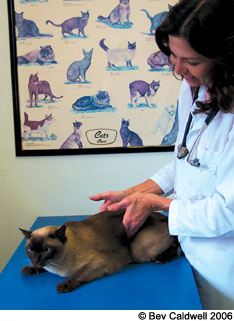As a former feral cat, Thomas, my elder beige tabby, has been in more tight spots than Houdini. If ever a cat needed pet insurance, it is probably him. In his younger, wilder days, I handled his veterinary expenses on my own. If I had known how much trouble he planned to get into over the years, I would have enrolled him in pet insurance long ago.
Indeed, whether or not to insure your cat is a question many pet owners ask themselves today. Researching the subject, however, can prove daunting. For example, a Google search of pet insurance immediately yields endless results. The maze of insurance policies, prices and choices can seem mystifying. To help you get started, check out the Pet Supplies Review on pet insurance (www.pet-supplies-review.com/pet-insurance.html). This site provides a comprehensive, understandable overview of the subject.

234
Any pet will benefit from pet insurance, says Brian Iannessa, a spokesperson for Veterinary Pet Insurance Company (VPI) in Brea, Calif. (for more about this company, see sidebar on next page). Any pet can succumb to an accident or illness at any age, so it makes perfect sense to be fiscally prepared for the unexpected. With veterinary medicine advancing to such a sophisticated level, treatments once only provided to humans are now available to pets. Those come with rising costs, too, and pet insurance takes the I cant afford it part out of the decision-making equation, he explains.
Encourages Preventive Care
With the addition of routine care, all pet owners can benefit, since responsible pet owners should take their pet in twice annually for preventive care as a matter of practice, he adds. (The cost of VPIs vaccination and routine care coverage is $99 per policy term, with reimbursements of up to $213 for certain well-care expenses. No deductible is applied to well-care claims.)
The pet insurance market is growing – VPI experienced a 130 percent increase in policies issued (new and renewed combined) between 2000 and 2004. Unlike European pet owners, however, Americans havent exactly embraced the idea; somwhere between less than one percent to five percent of us carry insurance for our pets.
The biggest challenge [facing the pet insurance industry] is awareness, Iannessa says. Youd be surprised at the number of pet owners in the U.S. who still have not heard of pet insurance.
Similar to insurance policies for people, pet insurance can be had in an amazing array of plans, deductibles and co-pay options, depending on the amount of coverage desired. As the pet owner, you pay an annual or monthly premium, and the insurance company reimburses an agreed-upon portion of your pets health care expenses after a claim or receipts are submitted. Policies for cats typically begin for animals as young as six to eight weeks, with age limits varying from eight years to the cats full lifetime.
To help you make the best possible insurance decision for yourself and your cat, Iannessa recommends the following tips.
Look for a company with a history. Some pet insurance companies come and go quickly, so make sure the provider has been around awhile.
Find out who underwrites the insurance. Does the company have a satisfactory A.M. Best rating? (This experienced rating agency grades insurance-related organizations on a scale from A+ to F; an A+ indicates a companys superior ability to meet their ongoing financial obligations to policyholders.) Does the underwriter have experience in processing pet insurance claims?
Choose an insurance plan that can be used anywhere. Some plans, such as discount programs, may limit you to certain providers.
Understand the product before you buy a policy. You will likely have questions about what conditions are covered, the average cost of premiums, and how the insurance works. (Take advantage of free, no-obligation, online quotes.) Cant find answers on the Website? Call the insurer and ask questions to your hearts content.
Ask your veterinarian for his or her recommendation. Many practitioners have first-hand experience with the leading insurers.
For multi-pet households, find an insurer that provides multiple pet discounts. With VPI, for instance, an owner insuring two or three pets receives a five percent discount on each base medical plan, while four or more pets qualify an owner for 10 percent off each base medical plan.
In addition, keep an eye out for the following limitations:
Exclusions. Pre-existing conditions – defined by VPI as any illness, accident, or injury that has been contracted or appeared prior to the effective date of your policy – are common exclusions in pet insurance policies. Other exclusions will depend on the policy you choose. Exclusions can often be covered for an additional cost.
Waiting periods. Be sure to note when a policy begins and ends. For instance, one company states that there is a 30-day waiting period on illnesses from the point of enrollment.
Caps. Be aware of pet insurance limits or caps on how much a company will pay for each illness or injury, per animal and per year. Pay attention to annual caps or lifetime caps.
Finally, before you sign up for pet insurance, be sure you know the answers to the following questions: Can I stay with my own veterinarian? Are prescriptions covered? Are routine veterinary visits (vaccinations, dental care, and flea control) included? Above all, read the fine print to ensure that you buy the peace of mind you desire.


